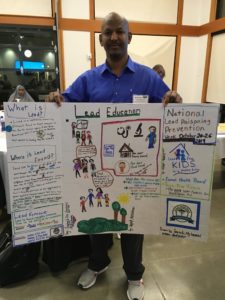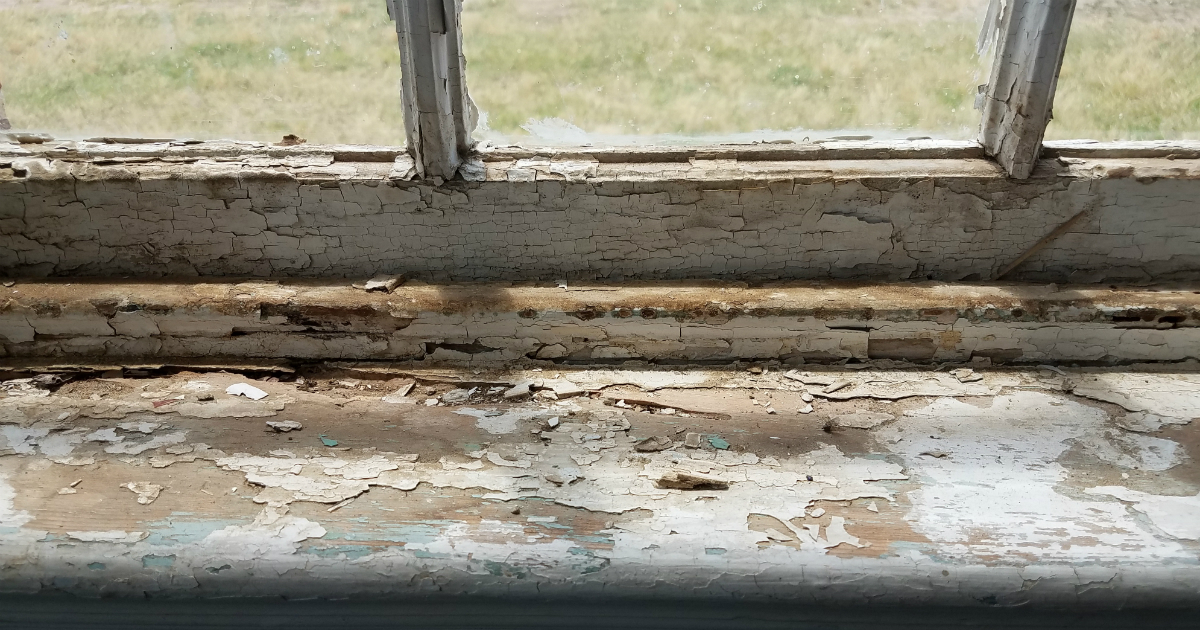Lead hazards are alive and well in King County, Washington, especially those due to household paint in homes built before 1978. Though a lot of progress has been made in the US bringing down blood lead levels in children through policy solutions including removal of lead from gasoline, household paint, and many consumer products, lead’s lasting impact lives on. And, lead hazards impact communities of color and low income communities in a disproportionate way.1,2,3,4 For example, a higher percentage of black children have concerning blood lead levels than white children, as do children living in lower income families vs. higher income families.3
This is unacceptable. And it’s why Toxic-Free Future serves on a lead awareness collaborative team project initiated by Seattle and King County Public Health, along with Living Well Kent, Somali Health Board, B.E.S.T. (Being Empowered through Supported Transitions), and Horn of Africa Services.

The lead awareness team is working hard to increase awareness of lead hazards in communities that experience disparities in exposure. The team has spent 2 years raising awareness of lead hazards through culturally appropriate focus groups, a train-the-trainer program, in-language trainings and videos, and lead shops open to the public. During this time, as the lead for Toxic-Free Future in the trainings, I was outraged to hear community members voice concerns like those paraphrased here:
- I did not know that lead could cause a great deal of harm, especially to children.
- My doctor never told me that my children can and should be tested for lead.
- I never got information from my landlord on how I can protect my children from lead.
- I’m afraid to ask my landlord about possible lead hazards in my home.
Priority Concerns
Distilling two priorities out of the last 2 years of community input, the lead awareness team has now embarked on a stakeholder process to find community-led solutions. The two priorities for the lead awareness team are: Access to Healthy and Lead-Safe Housing, and Increasing Blood Lead Level Testing in Children.
Access to Healthy and Lead-Safe Housing
Floor dust in the homes built before 1978 is the main source of lead exposure in children in the US.5 Older homes often have lead paint in them, and when this paint is worn or rubbed it contributes lead to house dust. Approximately 50% of housing in King County, WA was built before 19786 therefore about half of the housing in King County is likely to have lead paint in it, and people with lower incomes often live in these older buildings. In Washington state landlords are required to give prospective tenants information about how to protect their families from lead exposure and to disclose any existing lead hazards in the home they are about to rent. But there are no requirements that landlords abate lead hazards in their buildings, and landlords often don’t even follow lead disclosure and information requirements.
Increasing Blood Lead Level Testing in Children
There is no universal screening of children’s blood lead levels in King County and Washington state even though the impact of lead on children can be severe and lifelong. In fact, less than 5% of children in Washington have had their blood lead levels tested.7 The law requires that children on Medicaid be tested at 12 and 24 months of age – but here again this requirement is not being met with many health care providers mistakenly thinking that lead poisoning in children is not a problem in our state.
Community-Driven Solutions
The lead awareness team’s two stakeholder tables will provide a safe space for community members and housing providers and health care providers to air concerns, hear about all sides of the problem, develop and improve cross-sector relationships, and to voice creative new ideas for solutions around solving the lead exposure problem. The two stakeholder tables will culminate in a two-day conference open to the public in August 2020 that will provide exciting learning opportunities and create momentum around reducing disparities in exposure to lead.
It’s shocking that these two priorities identified by the lead awareness team are still an issue. Washington state has already developed potential solutions to these and other lead concerns8,9 but they have not been implemented, which is unacceptable. But we’re excited about the new energy and momentum the lead awareness team is creating in King County and in our state around protecting children and reducing disparities in exposure to lead, and we’re pleased to be part of this important work. Let’s move forward to protect all kids from the harmful, insidious toxic effects of lead.
References
1. Cassidy-Bushrow, A. E.; Sitarik, A. R.; Havstad, S.; Park, S. K.; Bielak, L. F.; Austin, C.; Johnson, C. C.; Arora, M., Burden of higher lead exposure in African-Americans starts in utero and persists into childhood. Environ Int 2017, 108, 221 – 227.
2. Bernard, S. M.; McGeehi, M. A., Prevalence of blood lead levels >=5 ug/dL among US children 1 to 5 years of age and socioeconomic and demographic factors associated with blood of lead levels 5 to 10 ug/dL, third National Health and Nutrition Examination Survey, 1988-1994. Pediatrics 2003, 112, (6), 1308-1313.
3. Wheeler, W.; Brown, M. J., Blood lead levels in children aged 1 – 5 years – United States, 1999 – 2010. MMWR Morbidity and Mortal Weekly Report. 2013, 62, (13), 245-248.
4. WHO, Exposure to lead: A major public health concern. In World Health Organization: Geneva, Switzerland, 2010.
5. Lanphear, B. P.; Matte, T. D.; Rogers, J.; Clickner, R. P.; Dietz, B.; Bornschein, R. L.; Succop, P.; Mahaffey, K. R.; Dixon, S.; Galke, W.; Rabinowitz, M.; Farfel, M.; Rohde, C.; Schwartz, J.; Ashley, P.; Jacobs, D. E., The contribuiton of lead-contaminated house dust and residential soil to children’s blood lead levels: A pooled analysis of 12 epidemiological studies. Environmental Research, Section A 1998, 79, 51-68.
6. Bureau, U. S. C.; Finder, A. F. Selected housing characteristics: 2013-2017 American community survey 5-year estimates for King County, Washington. https://factfinder.census.gov/faces/tableservices/jsf/pages/productview.xhtml?src=CF (12/20/19),
7. CDC, National Childhood Blood Lead Surveillance Data https://www.cdc.gov/nceh/lead/data/national.htm. In 2019.
8. Health, W. S. D. o. E. a., Washington state lead chemical action plan. In 2009.9. Governor, S. o. W. O. o. t., Directive of the Governor 16-06. In 2016.




